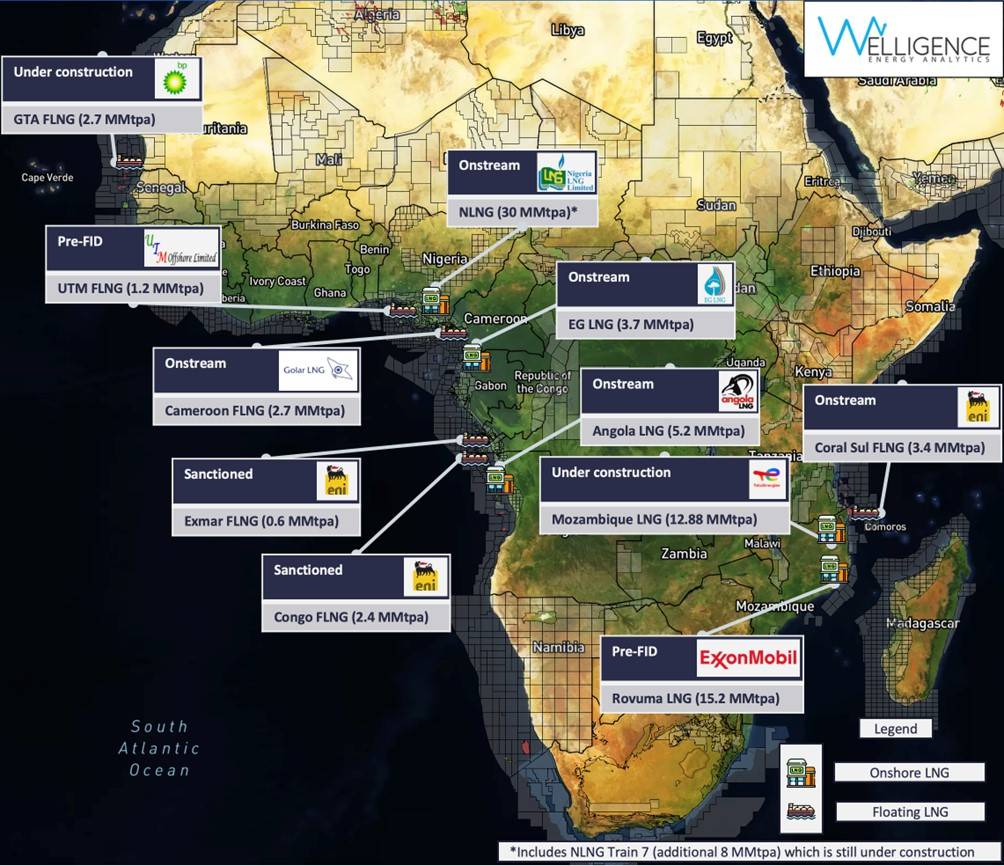Markets
Sub-Saharan Africa FLNG
Sub-Saharan Africa FLNG
Uniquely Positioned to meet European LNG Demand
By Obo Idornigie, VP for Upstream Research, Welligence Energy Analytics
Even as investment into new energies increases, the global hunger for gas is growing. It’s payday for producer countries, and companies are revisiting gas discoveries that have been classed as “stranded” for many years. The emergence of Floating LNG (FLNG) provides a means of monetizing these formerly unwanted finds. The shorter cycle times and lower capex can give FLNG technology an edge over traditionally much larger onshore liquefaction developments. One region where the FLNG solution is building real momentum is Sub-Saharan Africa (SSA).
After Golar’s 2.4 MMtpa Hilli Episeyo vessel started up in Cameroon in 2018, Eni fired up the region’s second FLNG vessel (the 3.4 MMtpa Coral Sul) last year in Mozambique. Several new projects are expected to start-up over the next few years, as gas resource holders pursue relatively short-cycle and low-cost access to global markets, particularly the hungry European market which lies in close, relative proximity. Our analysis of pro-posed projects highlights that the cost-stacks are well below expected European gas prices pre-2030, but at similar levels over 2030-2035 – quick start-ups are therefore vital to capture the opportunity.
Sub-Saharan Africa becoming a focal point for FLNG activity
Two new projects are expected online this year. Golar will provide the 2.45 MMtpa Gimi FLNG vessel to bp and phase one of its Greater Tortue Area (GTA) project in Mauritania/Senegal, while Eni acquired Exmar’s 0.6 MMtpa Tango FLNG unit and will deploy it on its Nene Marine project in Congo-Brazzaville. Furthermore, first steel was cut at Wison Heavy Industry’s yard in January for a second vessel (2.4 MMtpa), destined for the same Eni project (start-up in 2025).
-
New project sanctions in 2023: It’s not just European E&Ps looking at FLNG – ExxonMobil is carefully studying its options for Area 4 in Mozambique. While there is more than enough gas to support an onshore liquefaction plant, appetite to sanction such a development is uncertain due to the scale of investment required and long payback periods. We therefore believe the US Major is likely to go down the FLNG path, at least initially.
Another key project that may receive FID this year is phase two of bp’s GTA in Mauritania/Senegal. Both this, and Area 4 in Mozambique, can comfortably support 20-year 3.5 MMtpa LNG supply contracts. Golar has earmarked the Gandria LNG carrier for conversion to a 3.5 MMtpa vessel. The project location is uncertain at this stage, but Golar is confident it will online by 2025.
Sub-Saharan Africa LNG/FLNG projects

-
The next big gas play – Tanzania: The East African country, lying immediately north of Mozambique, is working to get its 30+ Tcf gas resource monetised, but we don’t see any near-term rush from the likes of Equinor and Shell to build an onshore facility. They may prefer to go down the FLNG path.
-
Shallow-water gas in Nigeria and Gabon: There are several stranded 2-3 Tcf gas discoveries across the two countries. These fields could utilise small FLNG vessels like the Hilli Episeyo. Alternatively, they could be candidates for New Fortress Energy’s Fast LNG solution. One project that is progressing is driven by UTM, a small Nigerian independent. It has entered the FEED phase to locate a 1.2 MMtpa FLNG vessl on the mature, ExxonMobil-operated Yoho field, where the gas will be supplied via blowdown.
Europe’s thirst for gas is a huge opportunity, supply chain constraints are a concern Most FLNG projects in SSA are backed by European operators, looking to supply their home market. The re-gion is expected to remain supply-constrained over the medium term given curtailments on piped gas imports from Russia. We estimate the full-breakeven cost for select pre-FID projects in SSA to access the European market is under US$8/MMbtu. With European LNG prices potentially averaging US$18/MMbtu out to 2030, now is a window of opportunity for suppliers to create enormous value.
The FLNG solution offers shorter cycle times and therefore access to this opportunity. But one concern for companies green-lighting new projects in the next 18 months is the tightening supply chain, particularly in the vessel construction yards. The shipyards in China have been beset with delays and are yet to recover from Covid-19 restrictions. Delays and cost inflation are therefore risks to companies’ ambitions.
FLNG cost per ton vs. lead time (sanction to first LNG export)*
*Bubble size proportional to liquefaction capacity. Based on estimated LNG export start dates for Gimi, Exmar and Golar Gandria. The Exmar vessel is the former Tango LNG vessel and will be repurposed for operations in Congo-Brazzaville.
About the Author:
Obo Idornigie is VP for Upstream Research at Welligence Energy Analytics, based in Edinburgh. He has over 15 years’ experience in the oil & gas analytics space, including extensive exposure to the Sub-Saharan Africa sector, as well as global company analysis.